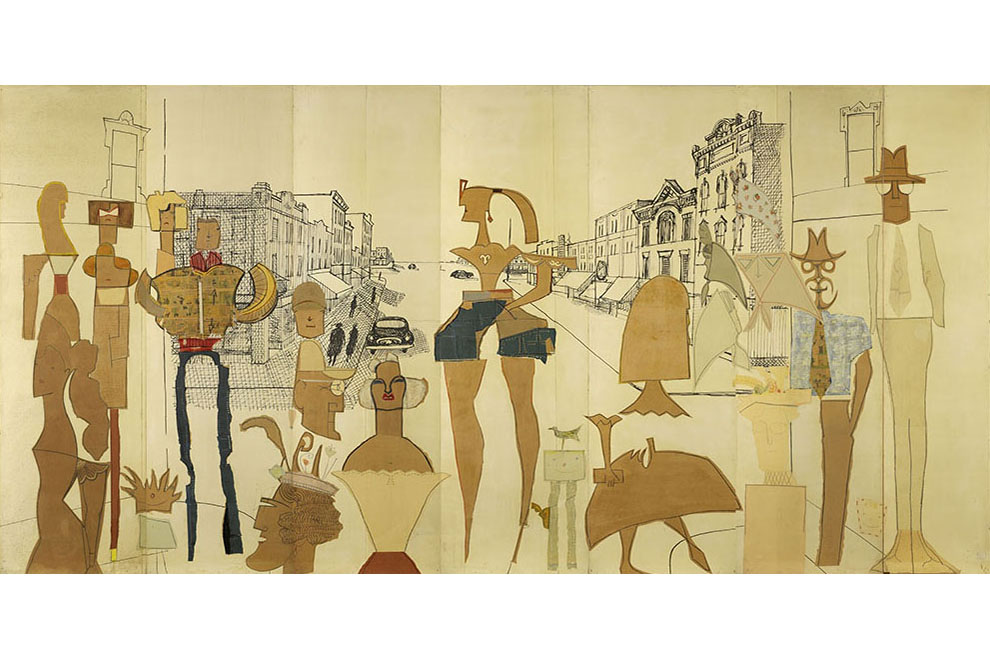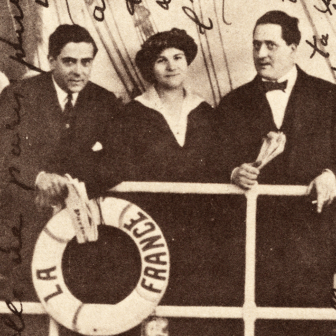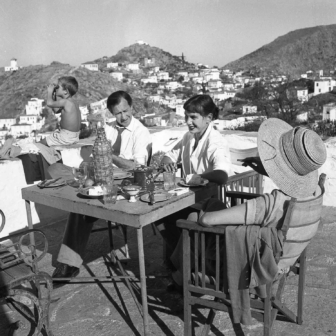The Americans, a monumental but little-known panoramic collage made by Saul Steinberg for the American Pavilion at the 1958 Brussels World’s Fair, is the centrepiece of an exhibition showing at the Museum Ludwig in Cologne until 23 June. Owned by the Musées royaux des Beaux-Arts de Belgique, this is the first time it has been exhibited in its entirety since the Fair. (Parts have been shown from time to time, but even the most extensive exhibition in Brussels in 1967 did not show the work complete.) As the catalogue essay by Melissa Renn suggests, its disappearance from view contributed to Steinberg’s omission from the standard histories of postwar art, histories that were being written while The Americans was in storage in Brussels. One could go a step further and speculate that the very path of postwar art, especially that of Pop Art, might have been different had this work been better known.
The project had been an ambitious one from the start. Bernard Rudofsky, the commissioning designer, asked Steinberg to think in terms of a billboard on a highway but also hoped he would come up with something “as monumental and durable” as Guernica. Monumental it certainly was: The Americans is ten times longer than Picasso’s famous Paris World’s Fair painting of 1937. The artist then topped a seemingly impossible comparison by saying it was “a sort of Bayeux tapestry showing Americans in their natural habitat from framehouse to penthouse…”
The Americans is not a mural in the traditional sense of an image painted on a wall. Rather, it was conceived as a mounted panel on a single forty-metre wall. As the plans progressed, however, the mural ended up nearly seventy-five metres long and three metres high, to be mounted on five separate walls, three of them freestanding and hence double-sided, giving eight vast surfaces in all. What Steinberg created for those surfaces shows his inventive virtuosity as a depicter of American types, ages and forms, in images that are sometimes admiring, sometimes amusingly satiric, but always sympathetic: the work is a summation of Steinberg’s observant curiosity about his adopted country. It also makes a substantial contribution to the body of postwar art, in dialogue, as Renn says, with other works of the time: Jackson Pollock’s poured paintings, Claes Oldenburg’s installations, James Rosenquist’s billboard-size works, as well as, given Steinberg’s combination of “artistic spontaneity with de-skilled labor,” the art of both Robert Rauschenberg and Jasper Johns.
BY THE time he arrived in Brussels in March 1958 Steinberg was already famous, in particular as the artist who had completely changed people’s understanding of how pictures are received and understood. The prime example was The Line (1954), a ten-metre scroll in which a perfectly straight horizontal line seamlessly transforms its meaning over twenty times from left to right: first it is the horizon of the Venetian lagoon, then a railway line over a bridge, then the nick between a building and the pavement as seen from above, then the edge of a balcony, and so on.
Born in 1914, Steinberg was raised in Romania, trained as an architect in Italy, and was hounded from that country in 1941; he became an American citizen in 1943, after which he served out the war in China and Italy with the Office of Strategic Services. On his return to the States he enjoyed early and rapid success – as a boundary-pushing cartoonist at the New Yorker, as an inventive commercial artist, as a muralist (by the mid-fifties he already had five murals to his credit, including the children’s labyrinth for the Tenth Milan Triennial in 1954), and as a sought-after artist in galleries across the country from New York to Los Angeles. In the early 1950s he exhibited in Italy (Galleria l’Obelisco, Rome), Britain (The Institute of Contemporary Arts, London), Brazil (Museu de Arte, São Paulo), and France (Galerie Maeght, Paris). Collections of his works, especially the ground-breaking The Passport, published in 1954, were hailed on both sides of the Atlantic, drawing praise from figures as different as Lionel Trilling, Le Corbusier and E.H. Gombrich, who wrote, in Art and Illusion, “there is no artist alive who knows more about the philosophy of representation.” The mural for the Brussels World’s Fair was to be the crowning achievement of the first half of this stellar career.
It is essential to grasp the titanic scope of The Americans. Each of the eight walls treats a different American subject. California, Florida and Texas begins with an assortment of West Coast fashion types, then passes to a densely compacted block parade of marching Shriners, matrons, blue-collar workers and businessmen both young and middle-aged, and ends with a group of five narcissistic, high-stepping drum majorettes. The Road – East and West (the longest panel, twenty-two metres) is dominated by a monumental three-metre-tall “big strong girl” accompanied by a group of hillbillies, cowboys and railwaymen (extruded Giacometti-like figures – the sculptor was Steinberg’s friend), “Siamese Twins” couples, other urban types, including children, drawn as was Steinberg’s wont in the style of the age depicted, competitive tourist-retirees facing each other, cameras at the ready, with wife-appendages sprouting out of their heads, and “good and bad cowboys.” Downtown – Big City shows city types accompanied by many eerily floating heads of businessmen. Baseball has three players in typical poses and a handful of fans against an empty stadium. Yet another Steinberg “big strong girl” towers over Mainstreet – Small Town, surrounded by a flock of women in headscarves, a torso-woman, a young man in a bomber jacket, and middle-aged men in shirtsleeves or suits and Trilby hats. Cocktail Party, on a black ground, is populated by intimidating uptown harpies and their speech bubbles, proliferating ectoplasms crammed with emphatic nonsense script, each one insinuating itself around the other, a fluid jigsaw puzzle of meaningless talk. Farmers – Middle West is anchored by the repeated motif of the rocking chair on the verandah – the chair and the person sitting on it form a gestalt, and the scene has a sleepy afternoon, small town geniality, about it. Finally, Drugstore – Small Town, spare and minimalist, the most melancholy of all the panels, on a pale grey-green field, shows, to the left, four partly dismembered diners hunched over the counter, and to the right, peeking above the cubicles, eleven heads staring out at the viewer: a badly assembled waitress trips between them.
Such a description can perhaps convey some idea of the range of the mural and the compelling strangeness of the figures, and reproductions of it will certainly accomplish more: but to really understand The Americans, it has to be seen. Up close one notices for the first time the flawless run of crayon lines describing an item of clothing or a facial expression, the sparing use of collage so that bits of wallpaper or the comics section of a newspaper will stand for a shirt pattern or the façade of a building, the heads made from shapes that have either been deftly cut to an outline or improvised from torn scraps of paper and then completed with a few marks to suggest the features. And only a viewing can allow the viewer to appreciate the folding and cutting that has produced so many of the figures. Thus, the husband-and-wife group that Steinberg called “Siamese Twins” is made from a two-and-a-half by one-and-a-half-metre sheet of paper, folded three times down its length, and then cut to produce a perfectly symmetrical husband-and-wife unit – the fold lines, still visible, are intrinsic to the wit. So, too, is the way the children and pet dog of a second couple are produced by cutting appropriate holes out of the parents. These techniques are most triumphantly present in the motor car in The Road, in which the grille is present as both positive and negative space – one half of the grille is what is left after the other half has been cut and folded out.
All these figures were pasted over a series of wonderful background drawings that were drawn in the United States and mailed to Brussels to be photographically enlarged seven weeks before the exhibition opened. The figures, about 130 of them, were created, and mostly devised, in Brussels. That work was conducted full-size, on site, and under trying conditions as to place, because the pavilion was being constructed around Steinberg while he worked, and time, because he left himself barely four weeks to create the figures. He wrote about the process of composition: “materials for the necessarily hasty population of the background with American prototypes and their belongings lay all about in the disorder of exhibits in the making – wrapping paper to circle the globe. Various shades were available, but sun-tan beige was most often suitable. Characteristic positive and negative patterns were improvised and cut or torn on the spot, then glued or stapled to the photographic paper. And at the end of three weeks of feverish assemblage eyes, noses, neckties etc. were drawn directly on the mounted wrapping paper shapes, usually with children’s crayon as the most expedient.”
Even allowing for some exaggeration, this account is exhilarating and not a little alarming: it underscores the precariousness of what Steinberg was doing. The making of The Americans was a race against time done at a feverish place with the ever-present possibility of failure. Steinberg’s account, too, hints at the only underdeveloped aspect of the mural, its too-oblique treatment of race, as it is hard to know whether any of the figures are intended to be African-American. (Steinberg had previously used brown paper to represent blacks.)
“My idea of the artist is the novelist,” Steinberg once rather mysteriously announced. But he often thought of his art in literary terms, going so far as to confess to an old school friend that a “failed writer” lived inside him. “I wanted to become a novelist when I was a teenager,” he said, and in a set of jotted notes, writing as the Romanian he often denied he still was, he emphasised that a key Eastern European characteristic was “the search for motive, like novelists.”
It is in terms of the novelist that one can sum up the effect of the extraordinary figures Steinberg has created. They are Steinberg’s depiction, by turns exuberant, savage and tender, of the American character: a testament to the excess and energy of American individualism and an appreciative critique of the strange shapes which America imposes on the bodies of its citizens, and the facial masks it invites them to put on. The figures celebrate typical characteristics such as conformity and individuality, constraint and freedom. But as the faces especially testify, these people are beings whose individuality is not submerged in their typicality: they have been created with a novelist’s care and respect for the selfhood of the other.
THERE is every sign the mural was recognised for the achievement it surely is. The collector Stanley Marcus told Steinberg it was “just about the greatest thing you have ever done,” and a fellow artist, Leo Lionni, whose own exhibit at the Fair, Unfinished Business, about race and poverty, was shut down because of protests back in the States, said it was “the best thing in Brussels.” In a different but – given that the Fair was a Cultural Cold War battleground – perhaps more telling register, the New York Times asked, “has any government satirized itself as… Steinberg has done with his airy, outrageous mural…?” In that respect alone, The Americans set the tone for the success of the American pavilion, which seduced Europeans with its self-effacing humour, completely eclipsing the earnest propaganda efforts of the Soviets in their pavilion next door.
Nonetheless the mural attracted less attention than it should have done, partly because, huge as it was, it had to contend with the overwhelming variety of displays on offer inside the pavilion – items such as Rudofsky’s tour around the United States in forty-eight objects (Idaho was represented by an irradiated potato, Alaska by a reproduction of the $7 million cheque paid to Russia for its purchase), a complete wall-mounted edition of the hundreds of pages of the Sunday edition of the New York Times, two motion pictures, one by Walt Disney, Circarama U.S.A., and the other a looped series of two- or three-minute vignettes of America by a group of young filmmakers (including a youthful Arthur Penn) projected onto twenty-five screens, the much-criticised “Islands for Living” with a bathroom designed by Rudofsky himself (he left out the plumbing), an early-model IBM computer that answered questions posed by visitors in ten languages, as well as the work of seventeen other artists besides Steinberg. Edward Durell Stone’s pavilion was itself so beautiful that it distracted from what was inside it – it was a mammoth circular structure with curtain walls, a pool in the centre, and a great eye in the roof like a twentieth-century Pantheon.
A sad story illustrates the missed opportunity that The Americans represented for Steinberg. Shortly after he had seen the mural the French publisher Robert Delpire proposed a publication on the project. Steinberg agreed. Delpire had the panels photographed, chivvied Steinberg into supplying an introduction and captions, produced a dummy, and by mid April 1959 had sent off page proofs to the artist. But Steinberg was bitterly disappointed with the plates. At the very last minute he withdrew his consent and the book never appeared.
This marks the beginning of the disappearance of The Americans. After the fair closed, it was cut into eighty-four vertical panels of about ninety centimetres each and consigned to the storerooms of the Musées royaux des Beaux-Arts de Belgique. Although some of the panels were reassembled for the exhibition in 1967, the mural soon fell from public view and, unavailable in reproduction, it was to all intents and purposes forgotten, especially in the United States. Yet it was in these years that the critical canon of postwar art was being formulated, a narrative from which Steinberg was excluded.
The exhibition at the Ludwig is accompanied by a fine catalogue, with text in German and English, edited by the curator, Andreas Prinzing, who also contributes a discussion of the Fair. As well as reproducing all eight panels of The Americans in generous size with a double gatefold spread for The Road, there are reproductions of the more than seventy other drawings and collages of the period, exhibited in side galleries. These put Steinberg’s achievement in the context of his contemporaneous art. As one of the world’s foremost museums of modern art – it has one of the largest collections of Picasso’s works in Europe – the Museum Ludwig, a magnificent building on the Rhine right next to Cologne cathedral, is the ideal place to exhibit the work. The exhibition brightly illuminates the mural’s place within major moments of the art of the 1950s, and must leave every visitor with the feeling that a comprehensive reassessment of Steinberg’s contribution to postwar art is long overdue. •




